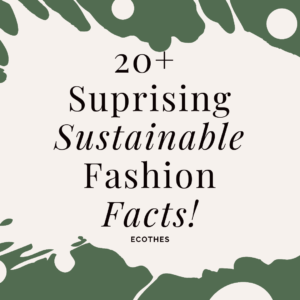The average American throws away 81 pounds of clothing every year. These discarded clothes add up to about 12 billion pounds annually.
As a whole, the clothing industry is one of the world’s most polluting industries in the world, generating 8.1% of the world’s greenhouse gas emissions.
Fast fashion is a major problem for almost everyone involved in the supply chain. There’s huge amounts of waste created, workers are often underpaid and working in dangerous conditions, and toxic chemicals are often used.
The first step in moving away from fast fashion is understanding the problem. In this post, we’ll show you exactly what fast fashion is, the impact it’s having, and how you can see through greenwashing and find sustainable alternatives.
What is fast fashion?
Fast fashion is a term that refers to clothes designed and sold at low prices, with the intention of quickly changing trends. Fast-fashion clothing often has little longevity because it’s made from cheaper materials or produced in less time than more expensive garments – which means they’re not meant for long use anyway.
How did fast fashion become mainstream?
People have always been interested in fashion.

The industry became truly mainstream in the 1990s, when H&M and Zara opened their first factories and stores, churning out clothes in a systematic process that had never been seen at a scale like that before. The industry has since grown to include many other retailers that are all competing for a share of this lucrative market – including Forever 21, Boohoo, ASOS, and many more.
What are the biggest fast fashion brands today?
The biggest fast fashion brands today are H&M, Zara (Inditex), and Uniqlo (among others). These companies are driving the growth of fast fashion and operating on a huge scale.

Despite growing awareness of the fast fashion industry’s impact, it’s still growing at an alarmingly fast rate.
How does fast fashion affect garment workers?
The garment industry is a global one – which means that many of the clothes we buy are made by workers in other countries.
Workers across the supply chain rarely make enough money to meet their basic needs and can’t afford education or healthcare.
Workers are often on poverty wages, earning 2-5x less than they need to live with dignity.
These workers also have little job security. When changes in the buying cycle or businesses occur, the poorest workers are the ones who are most affected.
How does fast fashion affect the environment and surroundings?
Fast fashion is a major contributor to the global waste problem. The industry produces an estimated 100 billion pounds of textile scraps per year, which are often shipped overseas and dumped in landfills or incinerated for energy production without any recycling process happening first – because it’s cheaper that way.
Fast fashion also uses an average of 27% more water than traditional manufacturing.
As much as 20% to 35% of all primary source microplastics in the marine environment are from synthetic clothing, according to academic estimates.
Experts predict that by 2030 there will be 148 million tons of fashion waste.
The fast fashion industry and consumerism has a huge environmental cost.
How can you tell if a brand is greenwashing?
Greenwashing is when a company advertises itself as environmentally friendly, but their practices don’t match up.
It’s important to look for the small details and do your research before you buy from any brand!
Here are some things that can help:
- Review the materials used, are they sustainable?
- Check for impact or environmental transparency reports (most fast fashion brands won’t publish these)
- A quick Google search for “Brand” + “Sustainability” (e.g. H&M Sustainability) can reveal a lot
- Do they have any recycling or re-use programs?
If you do end up purchasing from a brand that you later discovered was greenwashing, don’t beat yourself up over it. It’s often hard to tell, The key is to learn and make conscious decisions in the future, and consider donating or upcycling your garment at the end of its life to ensure it avoids landfill.
What are the economic impacts of fast fashion?
Fast fashion has been linked to the rise of disposable income and consumer culture.
It’s also created a cycle where people buy more clothes because they’re cheap, then throw them away when new styles come out.
We spend less money on every garment, but buy and waste more than ever before.
The apparel industry employs millions of people around the world, but many of these workers are often paid under minimum or living wages and work in dangerous conditions.
Can fast fashion brands really be sustainable or is it greenwashing?
Fast fashion retailers can be sustainable in theory. But, they have to make drastic changes in order for their clothing lines and business models to really make a difference.
They need more transparency about the origins of materials used; improving working conditions by paying workers a living wage or providing them with benefits like healthcare is also important.
The industry needs better regulation on chemicals that are harmful both during production as well at end-of time disposal (e g., pesticides, toxic dyes).
Some brands like Adidas, Gap, H&M, and Timberland are aiming to increase their use of Recycled Polyester (rPET) by at least 25% by this year.
In our opinion, you’re still better supporting brands that are built on a foundation of sustainability and slow fashion.



